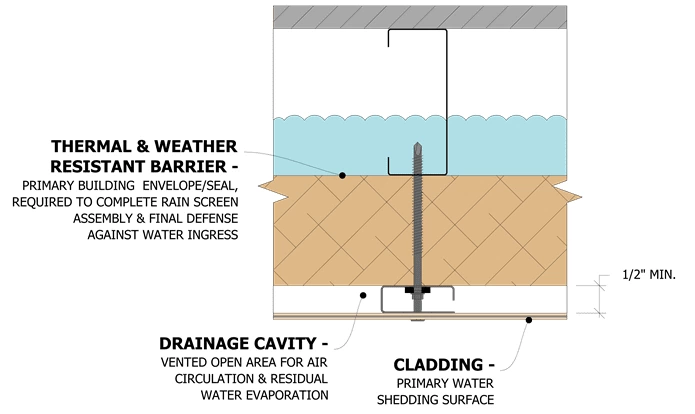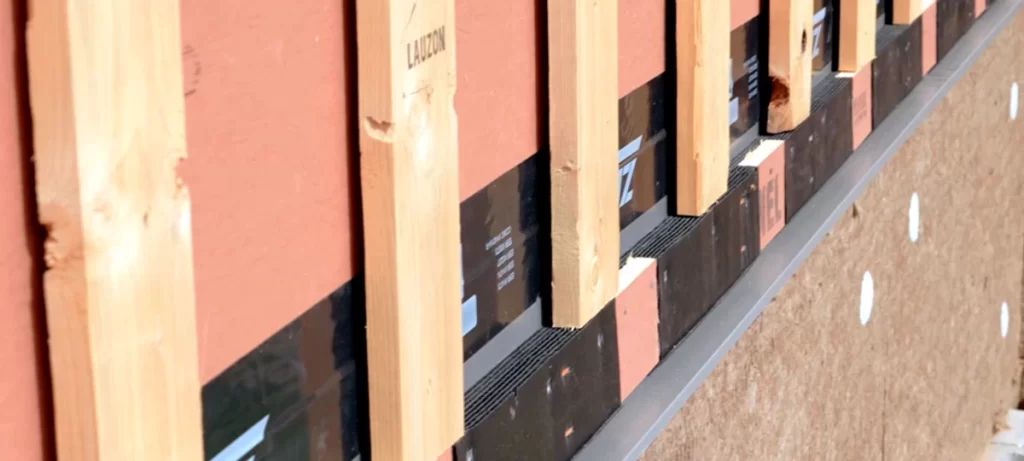What if there was a way to take that protection and style to the next level? Enter the rain screen for siding.
You may have heard the term “rain screen” before, but do you really know what Rain Screen for Siding is? In this blog post, we’ll look at rain screen for siding – what it is, how it works, and why it should be on every homeowner’s radar.
Get ready to discover a game-changing solution that will revolutionize your home’s exterior!
What is a rain screen?
A rain screen, in simple terms, is a protective barrier that is installed between the exterior siding of a building and its underlying structure. It acts as an extra layer to shield your home from the damaging effects of moisture. But don’t be fooled by its name – a rain screen does much more than just repel rain!
This innovative system allows for proper air circulation behind the siding, which helps to prevent trapped moisture or condensation from wreaking havoc on your home’s structure. By creating a gap between the siding and the wall, any water penetrating the outer layer can quickly drain away through weep holes or channels.
Not only does a rain screen protect against water damage, but it also enhances energy efficiency. Promoting airflow and reducing heat transfer through insulation creates an added thermal barrier that keeps your home cool in summer and warm in winter.
Rain screens come in various materials like wood, metal, plastic composites, or even stone veneers. They can be customized to match your aesthetic preferences while providing exceptional durability and longevity.
So why should you consider installing rain screen for siding? Aside from safeguarding your investment by preventing costly repairs due to moisture-related issues like mold or rotting woodwork, it also adds value to your property by increasing its lifespan.
Don’t let unpredictable weather dampen your spirits (or worse – ruin your beautiful siding). Embrace the power of a rain screen for siding! Our next section will explore precisely how this ingenious system works its magic.

How does a rain screen for siding work?
A rain screen is a system that is designed to manage moisture and protect the exterior of a building. But how exactly does it work? Let’s break it down.
First, the rain screen for siding consists of multiple layers. The outer layer, typically made of siding or cladding material, acts as a protective barrier against the elements. Behind this outer layer is an air gap or cavity, allowing ventilation and drainage.
When rainwater hits the exterior surface, some water may penetrate through small gaps or cracks in the siding. However, because of the air gap behind it, any water that gets past the outer layer can easily drain away rather than seep into the building envelope.
The ventilation provided by the air gap also helps to prevent condensation buildup within walls by allowing any moisture that does get inside to evaporate and escape.
Additionally, this airflow helps regulate temperature by reducing heat transfer from outside to inside during hot weather and minimizing heat loss during colder months.
A properly installed rain screen for siding system can greatly enhance both the durability and energy efficiency of a building by effectively managing moisture while maintaining good indoor air quality.
Remember – when it comes to protecting your home or commercial property from water damage, don’t overlook the benefits of a well-designed rain screen for siding system!

The benefits of a rain screen
The benefits of installing a rain screen siding are numerous and can significantly enhance the performance and longevity of your home’s exterior. Here are some key advantages to consider:
1. Improved moisture management: One of the primary benefits of a rain screen is its ability to manage moisture effectively. Creating an air gap between the siding and the wall allows any water that penetrates the outer layer to drain away, preventing mold, rot, and other moisture-related issues.
2. Enhanced energy efficiency: A rain screen can help improve your home’s energy efficiency by providing an additional insulation layer. This extra insulation helps reduce heat transfer through the walls, keeping your indoor spaces cooler in summer and warmer in winter.
3. Increased durability: The air gap created by a rain screen acts as a barrier against harsh weather conditions such as wind-driven rain or snowstorms. It helps protect both the siding material and underlying structure from damage caused by excessive moisture exposure.
4. Enhanced aesthetics: Rain screens offer endless design possibilities as they can be customized with various materials, colors, textures, and patterns to suit your personal style preferences. They can significantly enhance curb appeal while adding value to your property.
5. Easy maintenance: With proper installation, rain screens require minimal maintenance compared to traditional siding systems. The air gap allows for better ventilation behind the panels, reducing potential issues related to trapped moisture or insects.
6. Sustainable choice: Opting for a rain screen system demonstrates environmental consciousness since it promotes sustainability by extending the lifespan of both the siding material and building envelope components.
Incorporating a rain screen into your home’s exterior offers practical benefits and improves its overall aesthetic appeal while contributing positively towards sustainable construction practices.

How to install a rain screen
Installing a rain screen for siding may seem daunting, but with the right guidance, it can be a straightforward process. Here is a step-by-step guide on how to install a rain screen.
Gather all the necessary materials and tools. You will need furring strips, weather-resistant barriers such as building paper or house wrap, corrosion-resistant fasteners like stainless steel screws or nails, and side panels of your choice.
Next, prepare the wall surface by removing any existing siding and ensuring it is clean and level. Install the weather-resistant barrier by stapling or nailing it onto the wall surface according to manufacturer instructions.
Once the barrier is in place, attach horizontal furring strips vertically along the wall using appropriate fasteners. These strips create an air gap between the siding and barrier, allowing for proper moisture drainage for the rain screen for siding.
After securing the furring strips, you can install your siding panels. Start at one corner of the wall and work your way across horizontally or vertically, depending on your preferred style.
Attach each panel securely to the furring strips using the recommended fasteners provided by the manufacturer. Ensure that there is enough space between panels for expansion due to temperature changes.
Trim any excess material and ensure all edges are properly sealed against moisture infiltration.
Remember that these steps serve as general guidelines, and referring to specific installation instructions manufacturers provide for optimal results is essential. By following this process carefully, you can enjoy long-lasting protection from moisture damage with your rain screen system.
Also read about James Hardie Board Siding Contractor – New Orleans

Conclusion
A rain screen for siding is essential to any modern building design. It provides numerous benefits, such as improved insulation, moisture management, and protection against the elements. By creating a gap between the siding and the wall, the rain screen for siding allows air circulation and prevents water from infiltrating the structure.
The installation process may vary depending on the specific materials used and the design of your building. However, following manufacturer guidelines and consulting with professionals if needed can ensure a successful rain screen for siding installation that will enhance your property’s aesthetics and functionality.
Remember to choose high-quality materials for your rain screen system to maximize its effectiveness in managing moisture and improving energy efficiency. With proper maintenance and regular inspections, your rain screen will continue to protect your home or commercial building for many years to come.
If you are considering installing a rain screen for your siding or need assistance with any aspect of exterior construction or renovation projects, it is always recommended to consult with experienced contractors or architects who specialize in this field. They can provide expert advice tailored to your specific needs and help you achieve optimal results.
So don’t let weather-related issues dampen your spirits or compromise the integrity of your property’s exterior. Invest in a reliable rain screen system today and enjoy long-lasting protection against moisture intrusion while enhancing energy efficiency!

